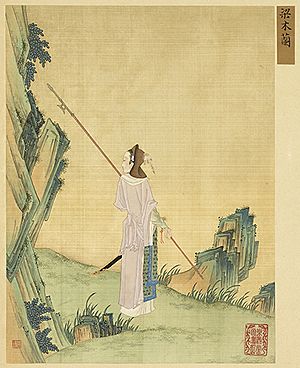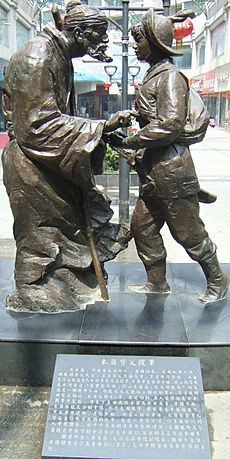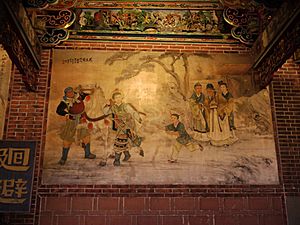Hua Mulan facts for kids
Quick facts for kids Hua Mulan花木蘭 |
|
|---|---|

|
|
| Information | |
| Gender | Female |
| Occupation | Cavalry soldier |
| Origin | Northern Wei |
| Hua Mulan | |||||||||||||||||||||||||||||||||||
|---|---|---|---|---|---|---|---|---|---|---|---|---|---|---|---|---|---|---|---|---|---|---|---|---|---|---|---|---|---|---|---|---|---|---|---|
| Traditional Chinese | 花木蘭 | ||||||||||||||||||||||||||||||||||
| Simplified Chinese | 花木兰 | ||||||||||||||||||||||||||||||||||
|
|||||||||||||||||||||||||||||||||||
Hua Mulan (Chinese: 花木蘭) is a brave Chinese folk heroine. Her story comes from the Northern and Southern dynasties era. This was a time in Chinese history between the 4th and 6th century CE. Many people believe Mulan is a fictional character. She is a symbol of courage and loyalty.
Contents
Discovering Hua Mulan's Story
Mulan's legend tells of her amazing bravery. She took her elderly father's place in the army. She did this by pretending to be a man.
Mulan's Military Service
The story says Mulan served in the army for a long time. She fought bravely against nomadic groups from the north. The emperor wanted to give her a high position. But Mulan said no. She just wanted to go home.
Returning Home
When she returned to her hometown, she met her family. Her army friends were very surprised. Mulan then revealed that she was a woman. This part of her story is very famous.
First Records of Mulan
The first written record of Mulan is the Ballad of Mulan. This was a folk song. People think it was written during the Northern Wei dynasty (386–535 CE).
The Ballad's History
The Ballad of Mulan was part of an old collection of songs. This collection is now lost. But important parts, like the Ballad of Mulan, still exist. They were saved in a later collection called Yuefu Shiji.
Historical Setting of the Ballad
The Ballad of Mulan usually takes place during the Northern Wei dynasty. This was when they fought against the Rouran people. Later versions of the story place Mulan around the start of the Tang dynasty (c. 620 CE).
Sources of the Mulan Legend
The Ballad of Mulan was first written down in a book called Musical Records of Old and New. This book was made by a monk named Zhijiang in the 6th century.
The Poem's Structure
The oldest existing text of the poem is from the 11th or 12th century. It's in a collection called the Music Bureau Collection. The poem is a ballad, so its lines don't always have the same number of words. It has 31 couplets (two-line stanzas). Most lines have five Chinese characters.
Later Adaptations
A writer named Xu Wei (who died in 1593) made the story into a play. It was called "The Female Mulan". Over time, Mulan's story became a very popular folk tale in China.
Mulan's Name
Mulan's family name changes in different versions of her story. Some old records suggest Mulan might have been her surname. This is because the Ballad of Mulan is set in the Northern Wei dynasty. This area was ruled by the Xianbei people, who were not Han Chinese. Their names were often compound surnames.
The family name Hua (Chinese: 花; pinyin: Huā; literally "flower") is the most popular today. This name was introduced by Xu Wei. It means "flower," which fits well with "Mulan" (Chinese: 木蘭), meaning "magnolia".
Was Mulan Real?
It is not clear if Mulan was a real person or just a legend. Her name is in a book called One Hundred Beauties. This book describes many women from Chinese folklore. However, her name is not in Exemplary Women. This book lists biographies of women from the Northern Wei dynasty.
The Ballad of Mulan doesn't say exactly when it happened. But it's often linked to the Northern Wei dynasty. This is because of the places and culture mentioned in the ballad. The Northern Wei rulers were originally nomads from the north. They were good at riding horses. This might explain why Mulan, a woman, was skilled in battle.
The Ballad of Mulan Story
Mulan is sad at her loom. The emperor is calling men to join the army. Her father's name is on the list. He is too old, and her younger brother is too young. So, Mulan decides to take her father's place. She buys a good horse and all the riding gear.
She says goodbye to her parents and leaves. She travels far to the Black Mountain. At night, she camps by the Yellow River. She can't hear her parents' calls. She only hears the sounds of the enemy cavalry in the Yan Mountains. She rides thousands of li to battle. The sound of the gong cuts through the cold night. Moonlight shines on her armor. Many battles happen, and generals fall.
After ten years of fighting, the soldiers return. They meet the emperor in his palace. He offers them promotions and many gifts. The emperor asks Mulan what she wants. Mulan refuses a high position in the government. She only asks for a fast horse to take her home.
Her parents are so happy to see her. Her older sister puts on her best dress. Her younger brother gets ready to prepare a feast. Mulan goes to her room. She changes from her soldier's uniform into her old clothes. She combs her hair and puts golden flowers in it. Her comrades are shocked when they see her. For twelve years, they fought together. They never knew she was a woman.
Mulan explains with a riddle: "The male hare has strong front paws. The female hare tends to squint. But when they run side-by-side, who can tell which is male or female?"
Modern Adaptations of Mulan

The story of Hua Mulan has inspired many movies, plays, and books.
Stage Shows
- Mulan Joins the Army (1917 play) starred Mei Lanfang.
- Mulan Jr. is a musical based on the 1998 Disney animated film.
- The Legend of Marissa Inouye (2013) was a dance show.
- The Ballad of Mulan was produced by Red Dragonfly Productions in the UK.
Films
- Hua Mulan Joins the Army (1927) was a silent film.
- Mulan Joins the Army (1939) was a Chinese film made during a war.
- Lady General Hua Mu-lan (1964) was a Hong Kong opera film.
- Mulan (1998) is a famous Disney animated movie. It led to many other Disney works. The Mulan character is also part of the Disney Princess line.
- Mulan, Rise of a Warrior (2009) was a Chinese live-action film.
- Many other Chinese live-action and animated films were made in 2020, such as Matchless Mulan and Kung Fu Mulan.
Television Series
- A Tough Side of a Lady (1998) was a Hong Kong TV drama.
- Hua Mu Lan (1999) was a Taiwan drama series.
- Jamie Chung played Mulan in the U.S. TV series Once Upon a Time (2012–2013).
- The Legend of Hua Mulan (2013) was a forty-nine-episode Chinese TV show.
- Star of Tomorrow (2015) is a children's program that adapted Hua Mulan's story.
Books
- Maxine Hong Kingston wrote about Mulan in her 1975 book The Woman Warrior. This book helped make the story popular in the West.
- The Legend of Mu Lan: A Heroine of Ancient China (1992) was one of the first English picture books about Mulan.
- Wild Orchid (2009) by Cameron Dokey retells the Ballad of Mulan.
- Mulan appears in the comics Deadpool Killustrated (2013).
- Reflection (2018) by Elizabeth Lim is an alternate ending to the Disney film.
- The Magnolia Sword: A Ballad of Mulan (2019) by Sherry Thomas tells Mulan's story with a twist.
- Mulan: Before the Sword (2020) by Grace Lin is a prequel to the 2020 Disney movie.
Children's Books
- The Ballad of Mulan by Song Nan Zhang (1998).
- I am Hua Mulan by Qin Wenjun (2017).
- Mulan: The Legend of the Woman Warrior by Faye-Lynn Wu (2019).
Video Games
- Mulan is a character in Kingdom Hearts II.
- She is a playable character in Smite.
- Mulan is an unlockable officer in Romance of the Three Kingdoms XIV.
- She is a summonable hero in Civilization VI.
- There was a Mulan video game for Game Boy in 1998.
- Mulan is a playable character in the mobile game Rise of Kingdoms.
Tribute in Space
A crater on the planet Venus is named Hua Mulan.
Images for kids
See also
 In Spanish: Hua Mulan para niños
In Spanish: Hua Mulan para niños
- Han E
- List of women warriors in folklore
- Valentina Ramírez Avitia
- Women warriors
- Joan of Arc




